How to Ensure Kitten Safety Outdoors

Allowing your kitten to encounter the big outdoors is equally exhilarating and anxiety-inducing.
As a caring owner, you want to keep your kitten safe while at the same time giving your kitten the chance to enjoy the benefits of fresh air and new experiences.
Kittens are innately curious and playful, which means they might not always appreciate the dangers lurking outside.
Outdoor environments can be hazardous for kittens—from predation to harsh environmental conditions—if not managed appropriately.
In this article, we will explore everything you need to know about keeping your kitten safe outdoors, starting with understanding the dangers they may face and how you can mitigate those risks.
Table of Contents
Understanding the Dangers of the Outdoors for Kittens
The outdoors can be unpredictable and, indeed, hazardous for kittens.
While fresh air and open space are beneficial for their development, there are many perils of which a pet owner should be aware.
Being aware of these dangers will better prepare you to protect your kitten during their outdoor excursions.
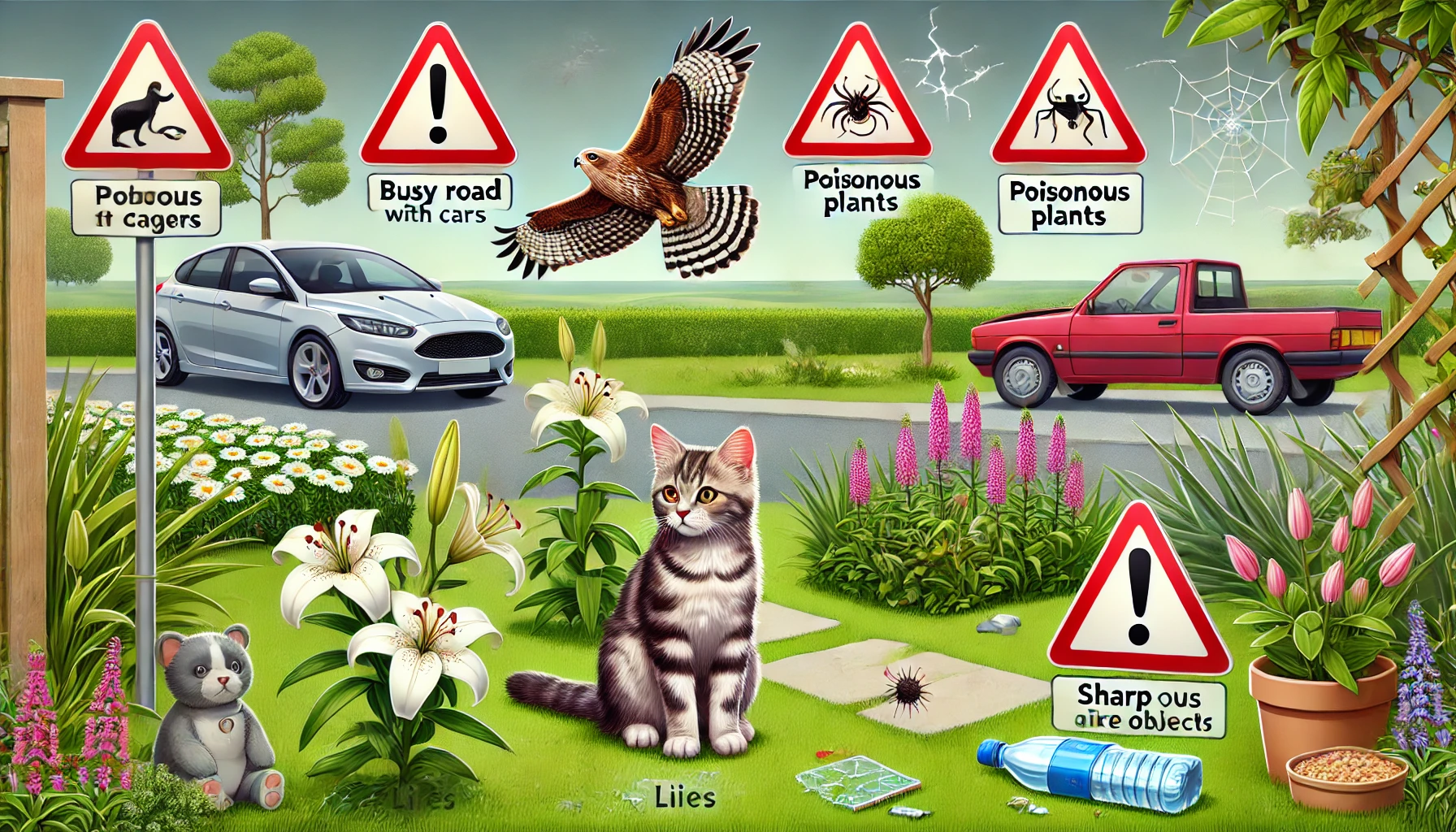
Common Hazards in Outdoor Environments
Some of the most common hazards that kittens may encounter outdoors include a mix of environmental risks and man-made dangers.
These hazards can be easily overlooked but are crucial to consider:
- Roads and Traffic: Kittens sometimes wander into streets where the risk of injury from cars is very high.
- Predators: Hawks, foxes, larger animals, or even other cats may pose a threat to your kitten.
- Poisonous Plants: Some common plants found in gardens and parks can be poisonous to kittens. Plants like lilies, azaleas, and daffodils are particularly dangerous.
- Parasites and Insects: Fleas and ticks can transmit diseases, and mosquitoes can make life very uncomfortable for your kitten.
- Sharp Objects: Broken glass, metal, or even thorns can cause injury if your kitten steps on them.

How Predators Pose a Risk to Kittens
One of the major dangers kittens face outdoors involves predators.
Predators such as hawks, owls, coyotes, and even neighborhood dogs can readily harm or frighten a kitten.
Due to their small size and inability to fully recognize potential threats, kittens can become easy targets for these predators.
It is essential to supervise your kitten during outdoor activities or ensure the area is secure from potential predators.
By being aware of these common hazards, you will be able to take proactive steps in creating a safe environment for your kitten, making their outdoor experience as enjoyable as it is secure.
Be cautious when allowing your kitten outdoors. The environment is unpredictable, and dangers like traffic, predators, and poisonous plants can threaten your kitten’s safety. Always supervise outdoor time and take necessary precautions to minimize risks.

Socializing Your Kitten to the Outdoors
First things first, get your kitten ready for an outdoor life.
Kittens are curious and often unaware of the many dangers lurking around every corner.
Preparation not only makes them safe but also builds their confidence in new territories.
From gradual introduction to the proper equipment, here’s how you can make their transition smooth and safe outdoors.
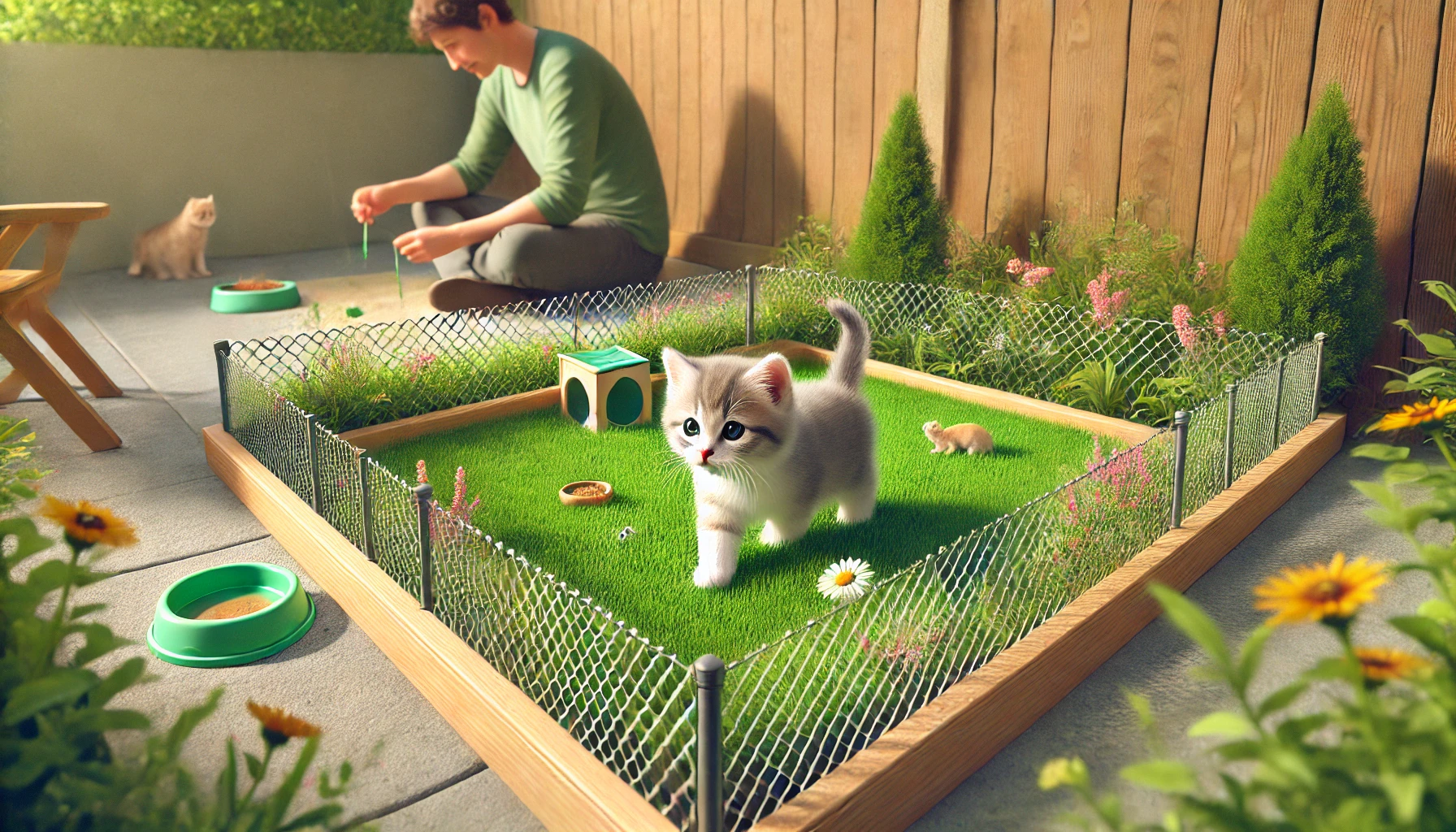
Gradually Introduce Your Kitten to Outdoor Areas
A gradual introduction can help your kitten become comfortable with the outdoors.
You can’t just let a kitten outside unsupervised, especially if it’s still quite young and untrained.
Start by introducing the kitten to small, enclosed areas, such as a backyard or balcony, while you provide constant supervision.
Short, supervised visits will help your kitten adjust to the various sounds, smells, and textures without overwhelming them.
- Start with short outings: Begin with just a few minutes outside and gradually extend the time as your kitten becomes more comfortable.
- Use familiar objects: Bring along toys or blankets your kitten already loves. Familiar scents can help reduce anxiety in a new environment.
- Monitor reactions: Pay attention to your kitten’s body language to ensure they are not stressed or frightened by the outdoor surroundings.

Using a Harness and Leash for Safe Exploration
A harness and leash can be a great option for letting your kitten explore outdoors safely while maintaining control.
Kittens are small and quick, making it easy for them to dart off if startled.
A well-fitted harness ensures they cannot slip out, while the leash allows you to guide their exploration without risks.
- Look for the right harness: The harness should fit comfortably—not too loose or too tight—so your kitten can move and breathe easily.
- Practice indoors first: Allow your kitten to get used to wearing the harness and leash indoors before taking them outside.
- Be patient: The harness-wearing process may take time. Use treats and patience to encourage your kitten to adapt.

Training Kittens to Respond to Calls or Commands
Training your kitten to respond to calls or commands is an important aspect of outdoor safety.
This allows you to get their attention if they wander too far or face potential danger.
Basic commands, such as coming when called, can be life-saving in certain situations.
- Basic commands: Teach your kitten to come when called by associating their name with a command like ‘come.’ Reward them with treats and praise when they respond.
- Positive reinforcement: Always reward good behavior with treats or praise. Avoid scolding your kitten if they don’t respond immediately.
- Be consistent: Consistency is key in training. Use the same commands and rewards each time to help your kitten understand what is expected.
With proper gradual exposure, the right equipment, and some basic training, you can ensure your kitten’s outdoor adventures are safe and enjoyable, minimizing risks from potential hazards.
Gradually introducing your kitten to outdoor environments helps them adapt safely. Use familiar objects, like toys or blankets, and supervise all outdoor outings to make the process smoother.
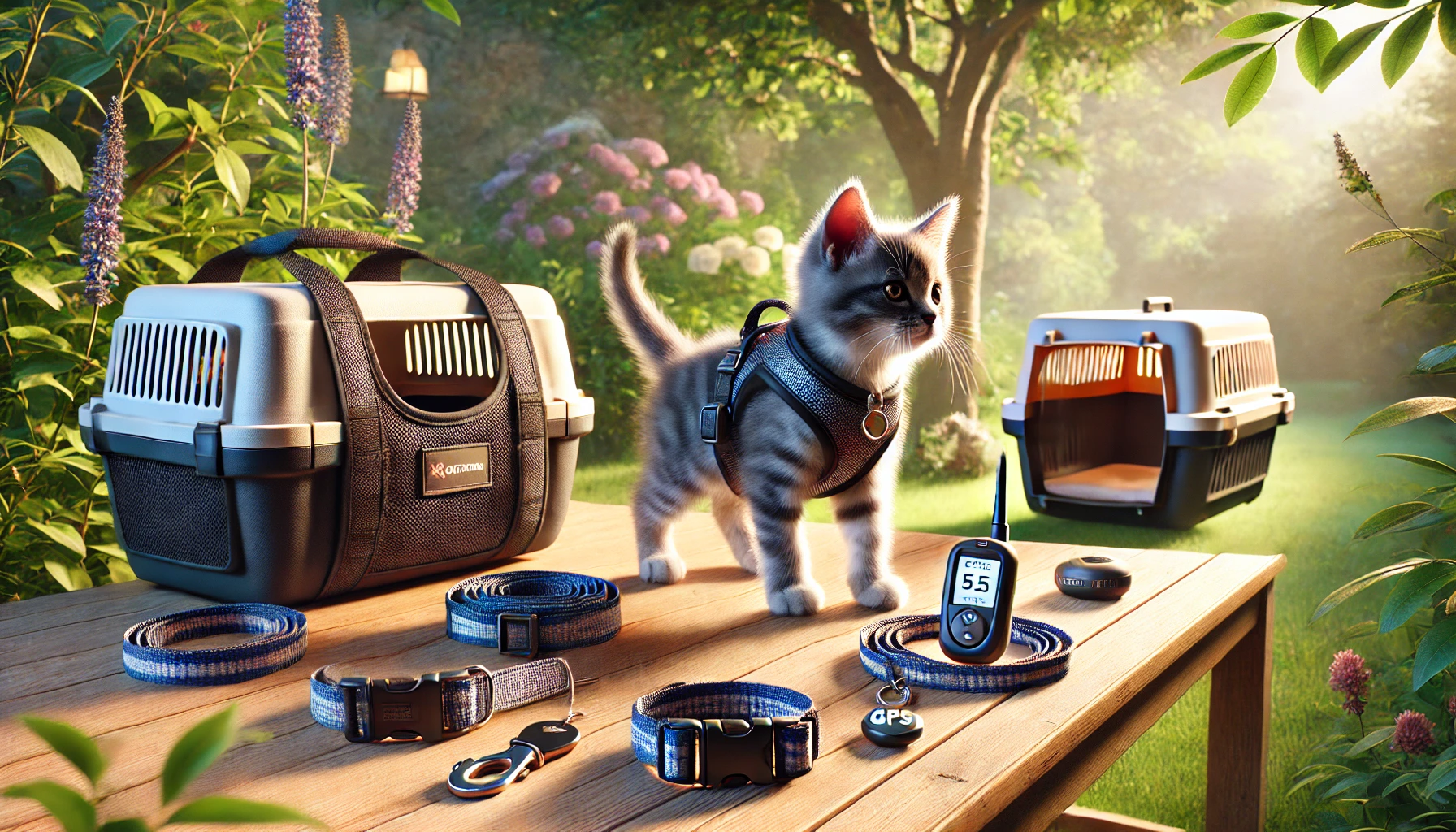
Essential Equipment to Ensure Your Kitten’s Safety Outdoors
Taking your kitten outdoors is all about setting them up for life and safety with the right equipment.
Proper equipment doesn’t just keep the kitten secure; it ensures exploration with confidence, keeping you in control.
From identification tags to protective clothing, here’s what every kitten needs for outdoor excursions.

Best Types of Collars and Identification Tags
One of the most important items for kitten safety outdoors is a collar with a proper identification tag.
If your kitten wanders off or gets lost, having an ID tag with your contact information can help ensure their quick return.
Not all collars are created equal, so you need to make sure you find one that is safe and comfortable.
- Breakaway collars: These collars are designed to snap open if your kitten becomes caught on something, reducing the risk of strangulation.
- Adjustable collars: Ensure the collar fits snugly but not too tight. You should be able to fit two fingers between the collar and your kitten’s neck.
- ID tags: Include your name and phone number on the identification tag. You may also want to include your veterinarian’s contact information for emergencies.

Using GPS Trackers for Kittens
GPS trackers have become a popular tool for tracking kittens during outdoor explorations.
These devices attach to your kitten’s collar and allow you to monitor their location in real time through apps on your smartphone.
This can be particularly useful if your kitten likes to roam far or if you live in areas with large open spaces.
- Lightweight trackers: Choose a GPS tracker that won’t weigh your kitten down or cause discomfort.
- Real-time tracking: Look for trackers that provide real-time updates so you can quickly locate your kitten if needed.
- Battery life: Opt for a tracker with long battery life to avoid frequent charging and ensure continuous monitoring.

How to Choose the Right Outdoor Carrier
An outdoor carrier is essential for safely transporting your kitten to and from outdoor locations.
A good carrier provides security and comfort whether you’re visiting the vet, heading to the park, or traveling to a friend’s house.
- Ventilation and comfort: Look for carriers with proper ventilation to keep your kitten cool, and make sure the interior is padded for their comfort.
- Secure closures: Ensure the carrier has sturdy zippers or latches that a curious kitten cannot easily open.
- Size and portability: Choose a carrier that is spacious enough for your kitten to move comfortably but compact enough for easy transport.
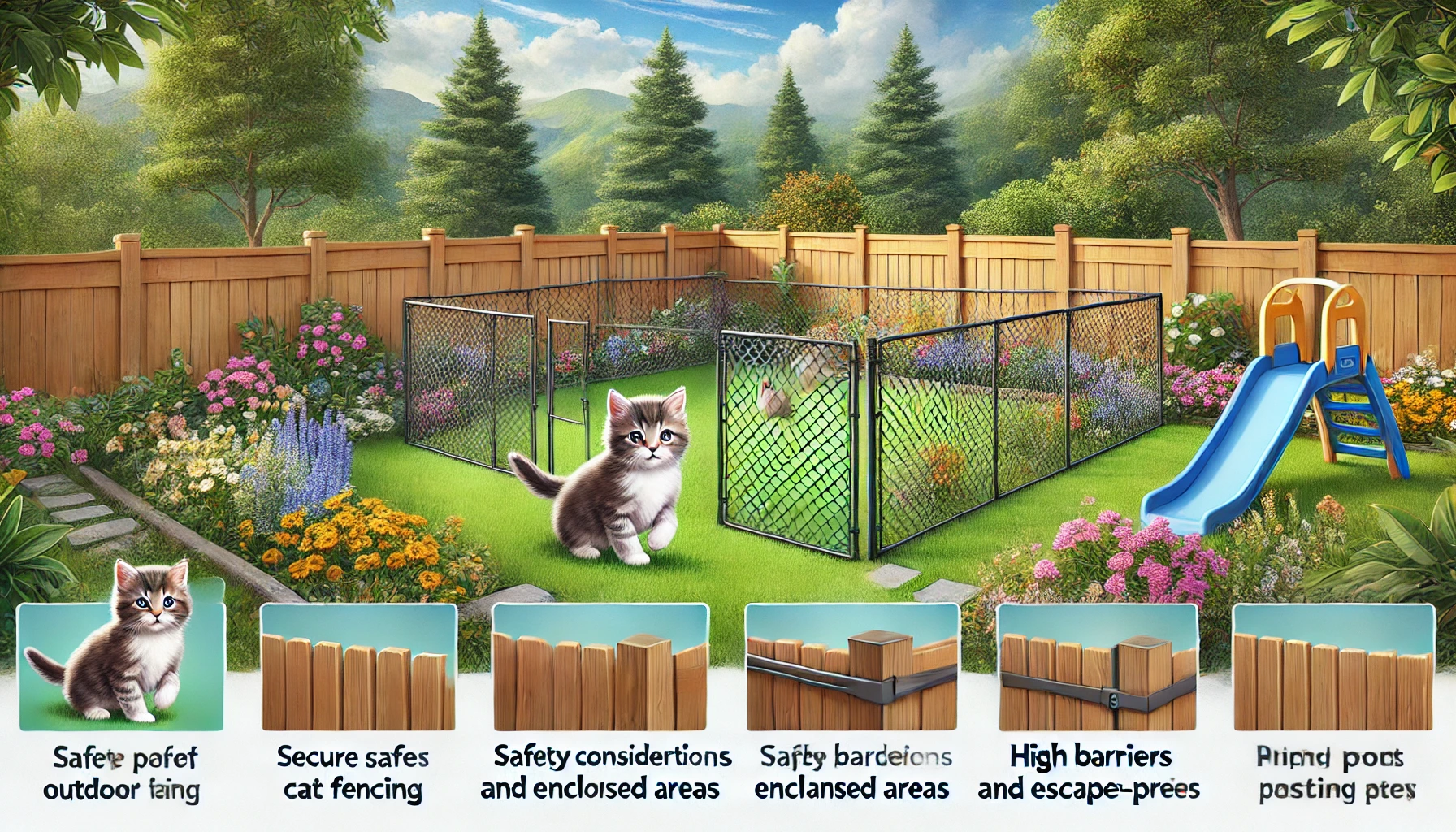
Safety Considerations for Fencing and Enclosed Areas
If your kitten will be spending time in your yard or outdoor space, installing proper fencing or using an enclosed area is crucial.
This ensures that your kitten stays in a safe zone and avoids potential dangers like traffic or predators.
- Cat-proof fencing: Consider installing cat-proof fencing or barriers to prevent your kitten from escaping.
- Enclosures: If fencing isn’t an option, use an outdoor cat enclosure or ‘catio’ to allow your kitten to enjoy the outdoors safely.
- Regular checks: Regularly inspect your outdoor space for gaps or weak points in the fence that your kitten could slip through.
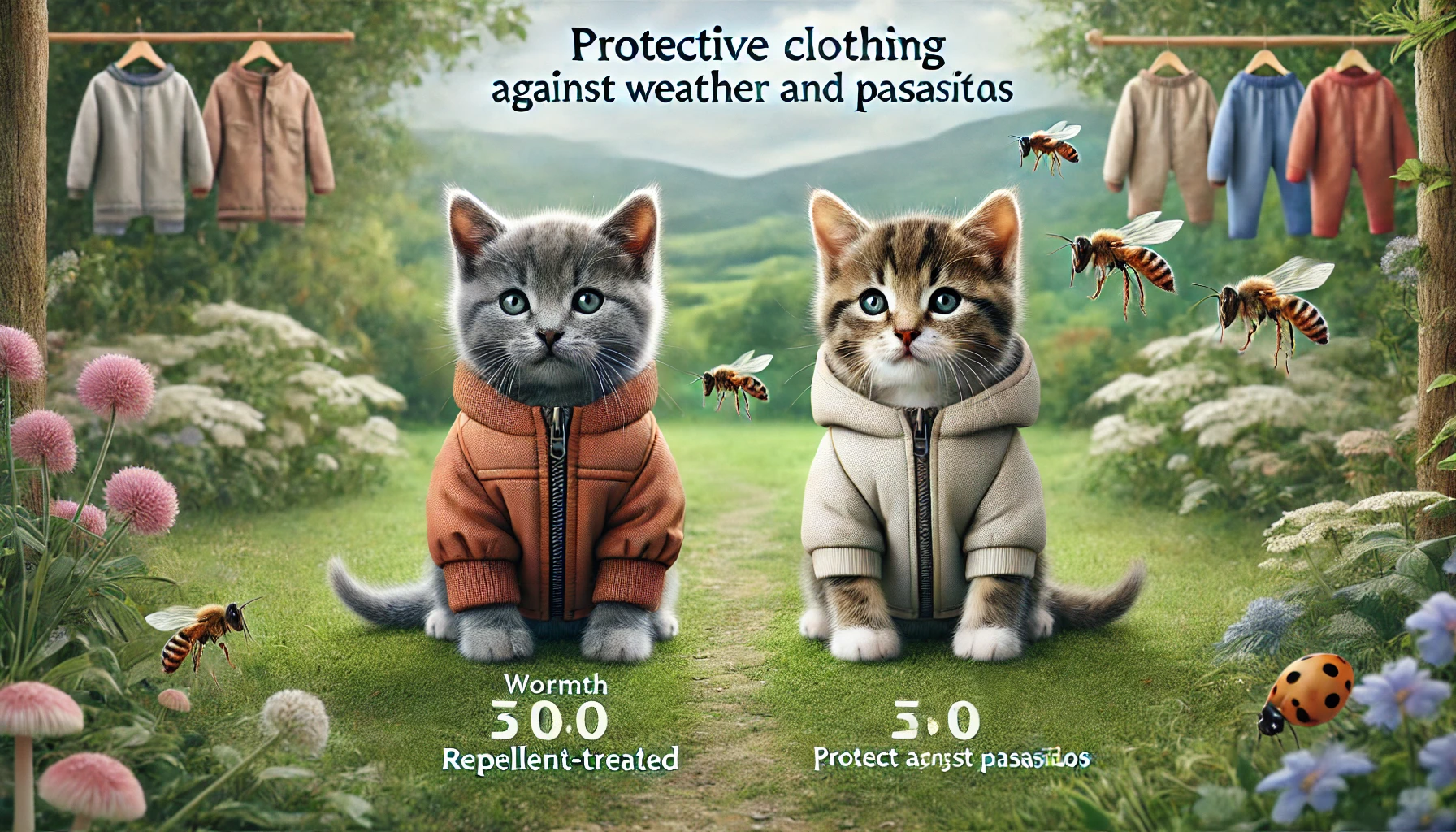
Protective Clothing Against Weather and Parasites
Depending on your location and climate, your kitten may need protective clothing to guard against harsh weather or parasites.
This can include jackets for colder weather or clothing treated with repellents to keep parasites like fleas and ticks at bay.
- Weather-related clothing: For colder conditions, consider a small jacket or sweater to keep your kitten warm, especially if they have short fur.
- Protection against parasites: Look for clothing treated with safe, vet-approved repellents to protect your kitten from fleas, ticks, and other parasites.
- Comfortable fit: Ensure any clothing you choose allows your kitten to move freely without discomfort.
By equipping your kitten with the right gear, you can ensure their outdoor adventures are safe and enjoyable.
With the proper tools at your disposal, you’ll be able to care for your kitten while keeping them safe from potential dangers.
Ensure your kitten is equipped with a breakaway collar, ID tag, and possibly a GPS tracker to guarantee their safety and easy identification in case they wander too far from home.

Creating a Safe Outdoor Home Environment
If you are going to let your kitten explore the outdoors, you will want to ensure that a safe outdoor home environment is created.
The outdoors offers numerous opportunities for mental stimulation and exercise, but there are definite dangers to consider and address.
Securing the space and making it kitten-friendly can provide an environment that is fun and safe for your furry companion.

Securing Your Backyard or Balcony for Kittens
If you have a backyard or a balcony, securing these areas is essential to prevent your kitten from escaping or getting into dangerous situations.
Kittens are naturally curious and love to explore, but they might get into trouble if the space is not secure.
- Install cat-proof fencing: Cat-proof fencing or barriers prevent your kitten from climbing out of the yard. Special designs are available to block kittens from climbing over the fence.
- Balcony safety: For apartments with balconies, using netting or plexiglass barriers can keep your kitten from falling or slipping through gaps.
- Cover potential escape routes: Check your fence or balcony for any gaps, holes, or weak spots where your kitten might escape.

Creating a Safe and Enriched Outdoor Play Space
Once your outdoor space is secured, it’s important to make it an engaging and stimulating environment for your kitten.
Keeping your kitten entertained helps reduce their interest in escaping or getting into trouble.
- Provide climbing structures: Offer safe and sturdy cat trees or outdoor shelves for climbing to keep your kitten amused.
- Toys and enrichment: Add interactive toys, tunnels, and scratching posts to encourage both physical activity and mental stimulation.
- Shade and shelter: Ensure there is a shaded area or a small shelter for your kitten to retreat to, especially during direct sunlight or sudden weather changes.
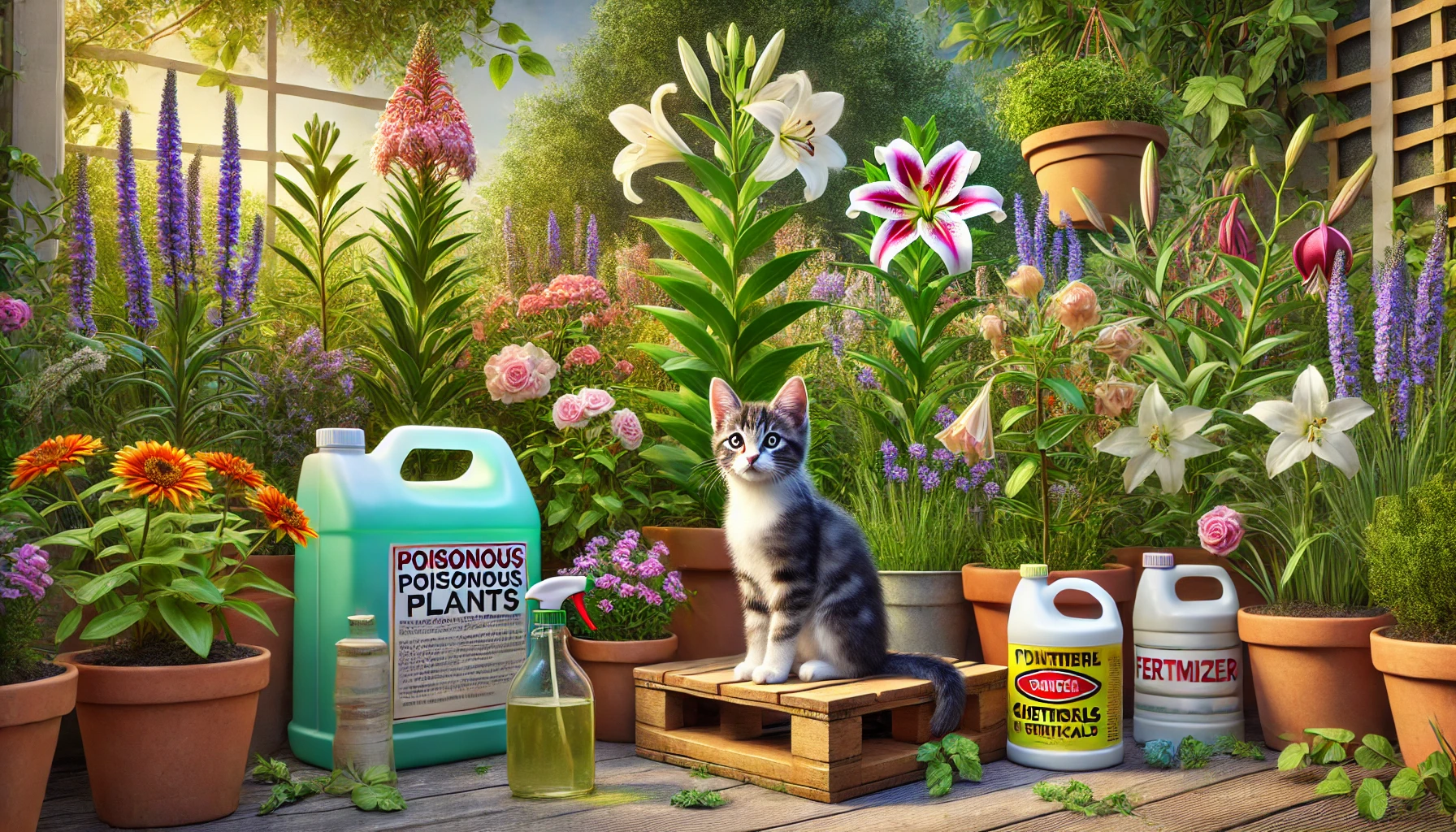
Poisonous Plants and Chemicals to Avoid
Outdoor environments can harbor hidden dangers, including poisonous plants and harmful chemicals.
It’s important to identify and remove any toxic substances from the area where your kitten will play.
- Avoid poisonous plants: Plants like lilies, azaleas, and oleander are toxic to kittens and should be removed or kept out of reach.
- Pet-friendly gardening: Use pet-safe fertilizers and pesticides when maintaining your outdoor space to avoid exposing your kitten to harmful chemicals.
- Keep chemicals locked away: Store lawn care products, paints, and cleaning agents in secure, inaccessible areas to prevent accidental ingestion or exposure.

The Importance of Regular Vet Visits for Outdoor Kittens
Even if your outdoor environment is secure, regular vet visits are essential for your kitten’s health.
Spending time outdoors exposes kittens to parasites, diseases, and potential injuries that can go unnoticed without proper care.
- Vaccinations: Ensure your kitten is vaccinated against outdoor-related risks, such as rabies and feline leukemia.
- Flea and tick prevention: Regular flea and tick treatments are important for outdoor kittens, as these parasites are common in grassy or wooded areas.
- Routine check-ups: Schedule regular vet visits to monitor your kitten’s health and catch any potential issues early.
By creating a safe and enriched outdoor environment, you can allow your kitten to enjoy the great outdoors while minimizing health and safety risks.
Secure your outdoor space with cat-proof fencing, and enrich the environment with safe toys and structures to keep your kitten engaged and within safety limits.

Handling Unexpected Situations When Your Kitten Is Outdoors
No matter how well you prepare or install safety measures, your kitten might still encounter unforeseen situations outdoors.
From getting lost to the possibility of attacks from other animals, it’s essential to be prepared for these emergencies and know how to react.
Having a plan can make all the difference in keeping your kitten safe and ensuring they return home safely.

What to Do if Your Kitten Gets Lost
One of the most distressing situations for any pet owner is when their kitten gets lost.
Kittens are naturally curious, and despite all precautions, they may disappear.
Here’s what to do if your kitten gets lost:
- Get into action: Search your immediate area as soon as you notice your kitten is missing. Kittens often stay close to familiar areas, so check nearby hiding spots.
- Call their name: Use a calm voice to call your kitten’s name and listen for any response, such as meowing.
- Post flyers: If your kitten is not found quickly, create flyers with a picture and your contact information, and post them around your neighborhood.
- Use social media: Post about your lost kitten on local social media groups or platforms like Facebook to increase the chances of someone spotting them.
- GPS trackers: If your kitten is wearing a GPS tracker, use the tracking app to locate them in real-time.

Handling Injuries and Emergencies
Accidents can happen outdoors, so it’s important to know how to handle injuries or other emergencies.
Basic first-aid knowledge and a kitten-friendly emergency kit can go a long way in urgent situations.
- Have an emergency kit: Keep a small emergency kit with essential items like bandages, antiseptic wipes, tweezers, and a pet-friendly first-aid guide.
- Assess the injury: If your kitten is injured, determine the severity of the injury. For minor cuts or scrapes, clean the area and bandage it. For more serious injuries, like broken bones or breathing issues, seek veterinary care immediately.
- Stay calm: Keeping calm will help your kitten remain calm as well. Gently handle them and reassure them with a soft voice.
- Contact your vet: If the injury is beyond your ability to treat, call your veterinarian or an emergency animal hospital right away.

How to Protect Your Kitten from Stray Animals
Stray animals can pose serious threats to kittens, either through aggression or disease.
Knowing how to handle encounters with stray animals is critical for keeping your kitten safe.
- Avoid stray animals: If you see stray animals in the area, keep your kitten inside until the area is clear.
- Supervise outdoor time: Always supervise your kitten when they are outdoors to prevent encounters with stray animals.
- Use a harness and leash: When taking your kitten outside, use a harness and leash to keep them close and under control.
- Report aggressive strays: If a stray animal is aggressive, report it to local animal control for the safety of your kitten and other pets in the neighborhood.

Responding to Signs of Stress or Overstimulation
Outdoor environments can sometimes overwhelm kittens, especially if they are not used to new sights, sounds, or smells.
Recognizing the signs of stress or overstimulation is important for your kitten’s well-being.
- Look for signs of stress: Signs of stress or overstimulation include flattened ears, dilated pupils, rapid breathing, and hiding.
- Take them away from the situation: If your kitten appears stressed, remove them from the outdoor environment and bring them inside to a quiet, familiar space.
- Comfort them: Offer your kitten comfort with their favorite blanket or toy, and talk to them in a soothing voice to help them calm down.
- Give time for acclimatization: If your kitten is new to outdoor environments, gradually increase their exposure to help them adjust.
Being prepared for unexpected situations will help ensure a safe and enjoyable outdoor experience for your kitten.
Whether they get lost, injured, or encounter stray animals, having a plan will make the outdoors much safer for them.
Stay prepared for emergencies. Keep an eye on your kitten, monitor for signs of stress, and be ready to act if your kitten gets lost or injured.
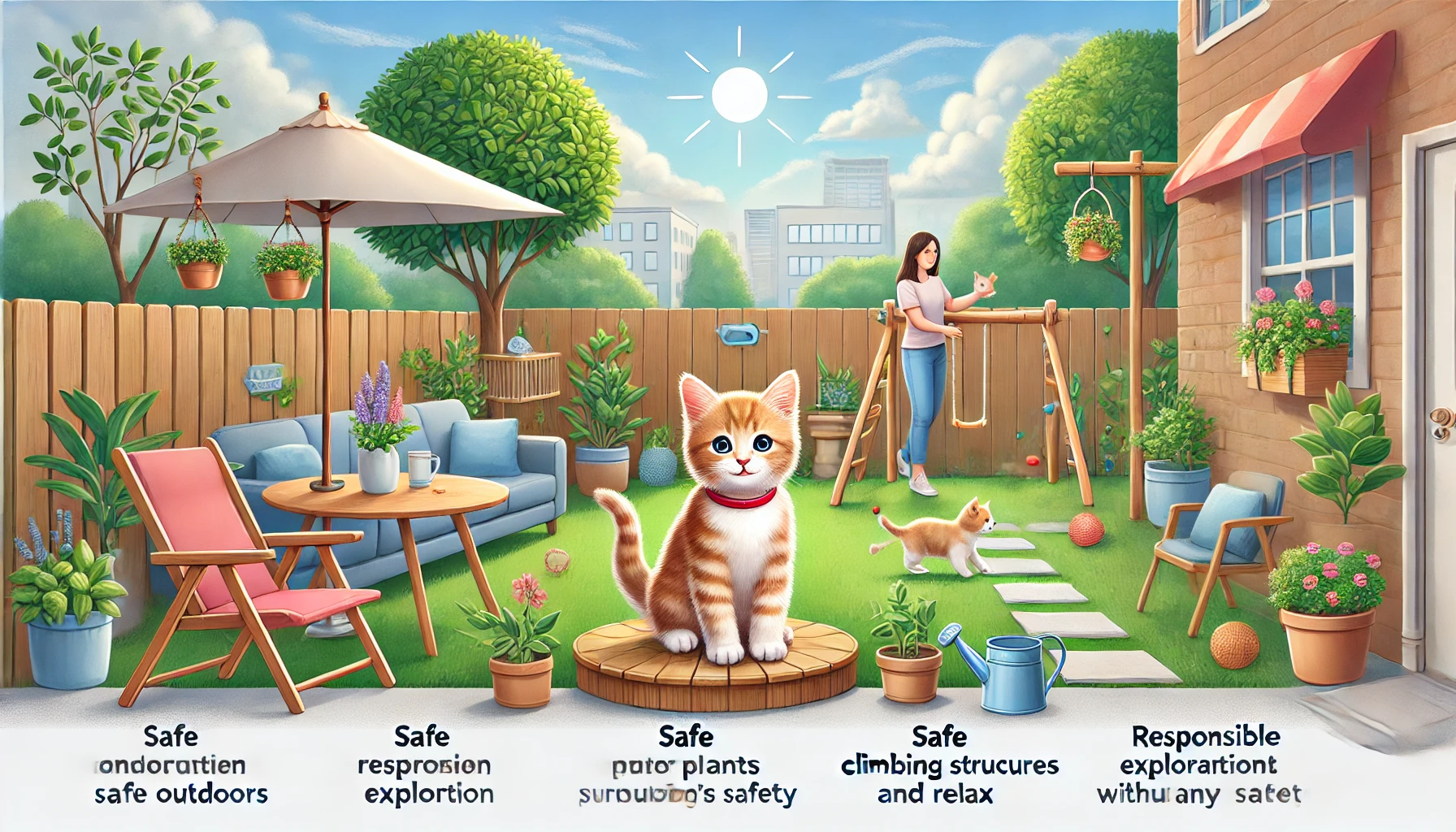
Keeping Kittens Safe Outdoors: Conclusion
Allowing your kitten to explore the outdoors can be a rewarding experience for both you and your furry friend; however, it comes with important responsibilities.
As discussed throughout this article, ensuring kitten safety outdoors requires thoughtful preparation, proper equipment, and vigilance to protect your kitten from potential dangers.
With the right precautions, you can ensure your kitten enjoys the outdoors safely and enrichingly with minimal risks.
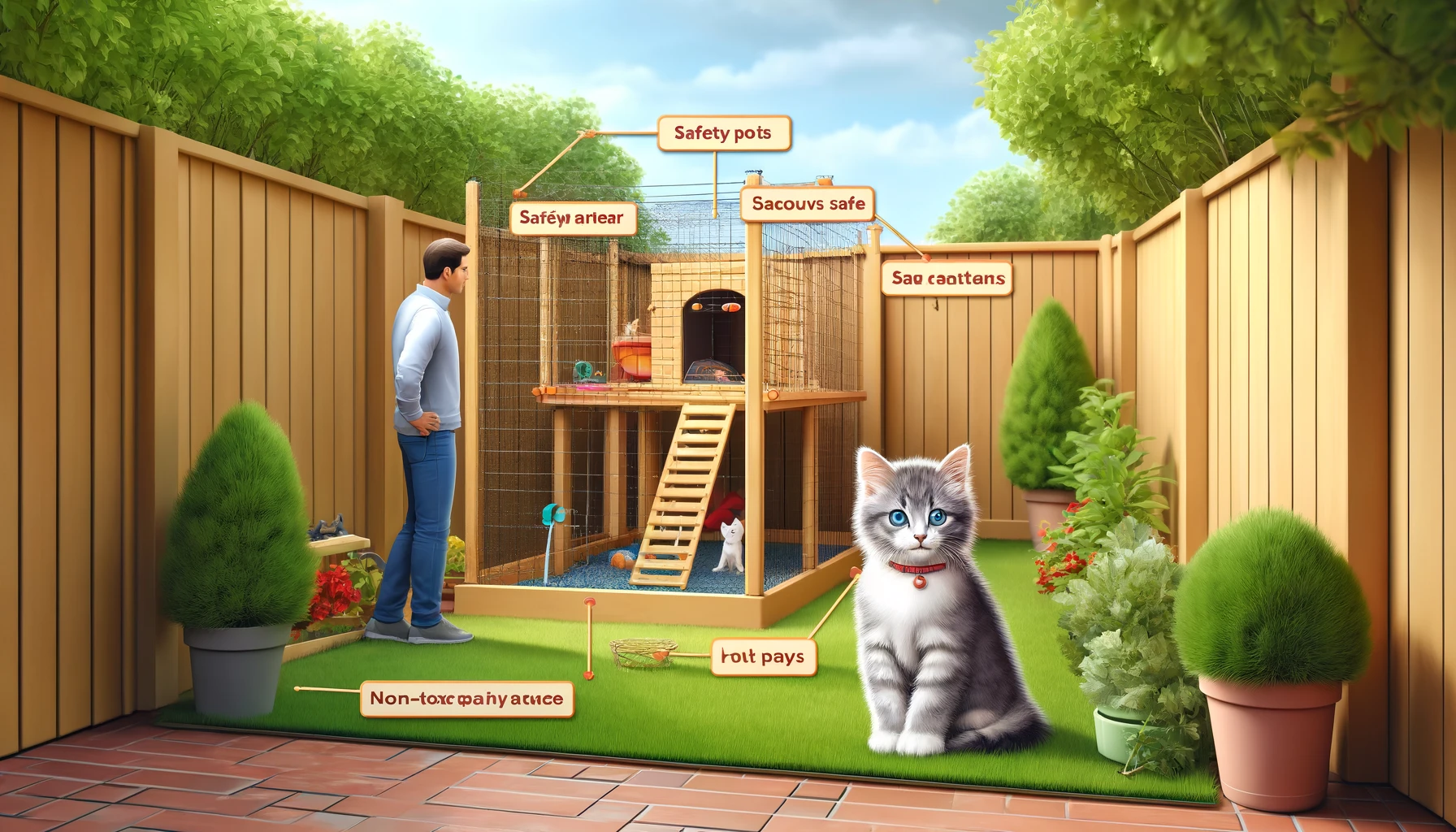
Important Points to Keep Your Kitten Safe
Here are key steps you must take to ensure kitten safety outdoors:
- Secure your outdoor space: Whether it’s your backyard or balcony, make sure it is kitten-proofed with cat-safe fencing or barriers to prevent your kitten from escaping or encountering danger.
- Use essential gear: Equip your kitten with a collar bearing an identification tag, a GPS tracking device, and use an outdoor carrier for safe exploration.
- Provide an interesting environment: Keep your kitten entertained with toys, climbing structures, and shaded areas. This will keep them within the safety boundaries you’ve established.
- Safeguard against stray animals and dangers: Always supervise your kitten outdoors, prevent interactions with stray animals, and remove any toxic plants or chemicals from the area.
- Prepare for emergencies: Be ready for unexpected situations such as your kitten getting lost, injured, or stressed. Having a first-aid kit and basic knowledge of emergency care is essential.

Gradual Exposure and Check-ups Are Important
Gradually introduce your kitten to the outdoors by starting with short, supervised outings.
As they become more comfortable, you can extend the time they spend outside.
Kittens need time to adapt to the new sounds, sights, and smells of the outdoor world, so be patient and offer support during this process.
Regular veterinary check-ups are essential for outdoor kittens.
Vaccinations, flea and tick prevention, and routine health checks will help protect your kitten from the diseases and parasites they may encounter.
Keeping your kitten healthy ensures they can continue exploring safely.

Confidence and Control for You and Your Kitten
By following the steps outlined in this guide, you can confidently allow your kitten to experience the outdoors while keeping them safe.
Equipping your kitten with the right tools, creating a secure environment, and preparing for contingencies will give you peace of mind and help your kitten thrive during their outdoor adventures.
Remember, kitten safety outdoors is an ongoing process.
Continuously monitor your environment and your kitten’s behavior, making adjustments as needed.
With the right approach, you can provide your kitten with a secure and fulfilling outdoor life that balances exploration with protection.
Keeping your kitten safe outdoors requires constant supervision, the right gear, and a prepared mindset. Equip your kitten with the necessary tools and ensure you’re ready to handle any unexpected events.
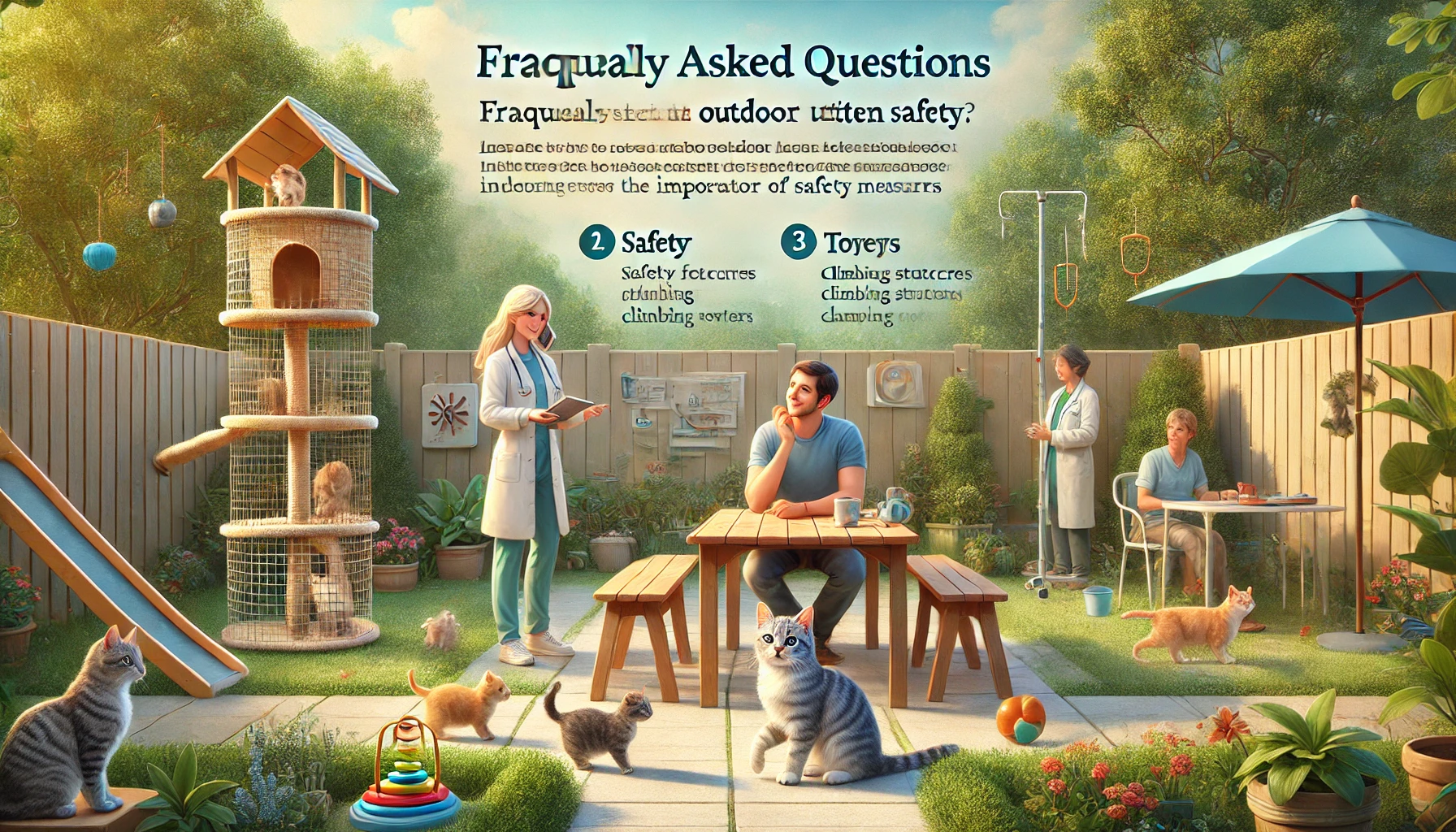
Frequently Asked Questions About Outdoor Kitten Safety
Below are some of the most frequently asked questions regarding how to keep your kitten safe when they begin to explore the outdoors.
These answers offer quick, helpful insights to ensure your kitten’s outdoor adventures are safe and enjoyable.
How do I prevent my kitten from getting lost outdoors?
Put a collar, ID tag, and GPS tracking device on your kitten.
Only allow supervised outdoor time and ensure your yard or balcony is kitten-proofed to prevent your kitten from wandering into hazardous areas.
Is it safe for kittens to be outside unsupervised?
It is not recommended to let kittens outside unsupervised.
Kittens are curious and can easily encounter dangers such as predators, traffic, or toxic plants.
Always supervise your kitten outdoors to ensure their safety.
At what age can a kitten be best brought outdoors?
It is ideal to wait until your kitten is at least four to six months old, vaccinated, and more confident before gradually introducing them to the outdoors.
How do I protect my kitten from fleas and ticks?
Use vet-approved flea and tick prevention treatments for your kitten, and regularly check for parasites.
Avoid areas with tall grass or wooded environments where fleas and ticks are more prevalent.




